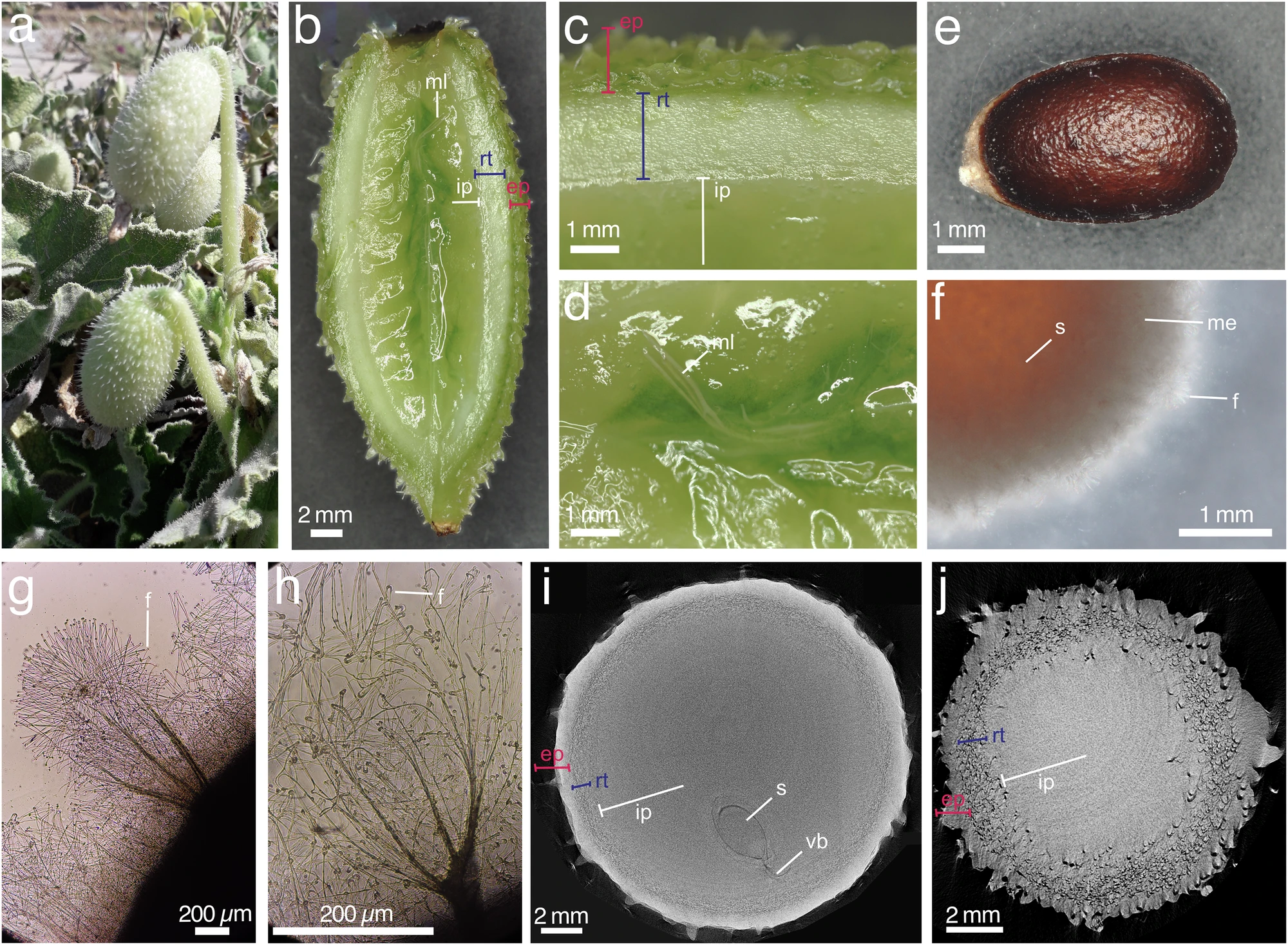A Tiny Hydro‑Cannon in the Meadow
Native to Mediterranean scrublands, the squirting cucumber (Ecballium elaterium) pops with an audible pop, hurling its seeds impressive distances. A recent open‑access Nature paper combined 3D µCT, high‑speed videography, electron microscopy, and micro‑mechanical testing to unpack this explosive system. How does the plant embed physical “best practices” into living tissue? Let’s walk through the key findings.
A Water‑Powered “Natural Cannon”
Inside the fruit, parenchyma cells(†) draw in water, raising internal (turgor) pressure to peaks near 0.8 MPa—four to five times a car tyre. Once the limit is reached, a cork‑like septum at the fruit stalk detaches in a flash, and viscous juice acts as a propellant to eject the seeds. No gunpowder, no springs—just water pressure: the ultimate eco‑engine.
The fruit’s three‑layer wall—exocarp, mesocarp, endocarp—plays key roles. Robust cellulose microfibrils in the mesocarp bear the tensile load, while swollen parenchyma presses from within. When tension surpasses the threshold, rupture starts at the stalk where stress concentrates, neatly unsealing the muzzle.
†Parenchyma cells are basic plant cells with thin walls, responsible for photosynthesis, storage, and metabolism. Their flexibility allows dramatic swelling.
A Self‑Setting Launch Angle of 53°
As ripening progresses, the stalk elongates by several centimetres and straightens to less than one‑third of its original curvature. The fruit‑stalk angle stabilises around 53°, slightly above the 45° theoretical optimum, fitting real‑world aerodynamics for 5–6 mm seeds. Simulations confirm 50–55° maximises range.
Gene‑expression data show peaks in cellulose‑synthase transcripts during this rapid stalk growth. An auxin gradient across the stalk likely biases cell elongation, locking in the final launch angle.
3D µCT Reveals a Six‑Row “Magazine”
Non‑destructive X‑ray micro‑tomography reconstructed the fruit in 3‑D. Seeds align in six rows, up to 53 seeds per fruit, arrayed like wheel spokes around a juice‑filled central channel. At firing, the channel becomes a high‑flow conduit that pushes every seed evenly.
Cellulose fibres in the mesocarp align ±20° to the firing axis, guiding stress toward the muzzle. FT‑IR spectra show lignin 15 % lower in this zone, creating a built‑in, more flexible rupture line—a cellular fuse.

High‑Speed Cameras Capture Real‑World Ballistics
At 10,000 fps, seed launch completes within 30 ms. The average exit velocity is 10 m/s (~36 km/h), and the farthest seeds land 12 m away. A non‑linear speed profile appears: seeds from central rows travel farther, while edge rows lag slightly.
Fluid simulations indicate the viscous juice cuts friction by >20 %, extending range 1.3‑fold. Too much viscosity would slow the launch, so the plant keeps sugar content between 18–22 %, balancing speed and lubrication.
Juice That Hardens into “Instant Glue”
In flight, the juice is all lubricant; on landing, it becomes glue. Within minutes it dries into a cellulose film with 27.5 N (2.8 kg‑force) peel strength. As water evaporates, β‑1,4‑glucan chains realign into a nanofibre network. Atomic‑force microscopy shows the dried film’s modulus hitting 3 GPa—wood‑level stiffness.
In vitro drop tests on sand confirm the glue’s role: adhesion passes 10 N in 30 s and plateaus in 5 min. Seeds without juice stick at only 0.23 N. The hard‑curing film firmly anchors seeds in dry soil.
Take‑Home Message
The squirting cucumber orchestrates three biomechanical tricks—auto‑adjusted launch angle, a six‑row seed magazine, and juice that flips from lubricant to glue—to send its seeds a record 12 meters. High‑resolution imaging and physics‑grade measurements now quantify every stage, from internal pressure build‑up to cellulose‑fibre alignment.
Next time you spot a small cucumber swaying in the scrub, remember the silent hydro‑engine waiting inside—plants can be surprisingly dynamic engineers!



コメント